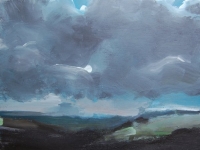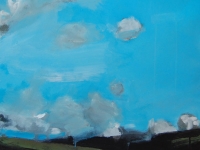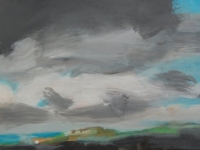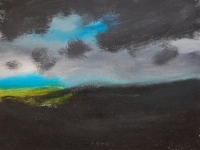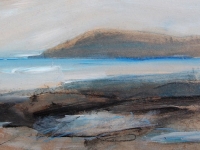‘Things Seen: the sky paintings of Ian Mood’
Text by Michael Howard, M.A., F.R.S.A.
Landscape can be one of the most conservative of genres, but in the hands of a sensitive, questing artist it can become one of the most radical.
Ian Mood is an artist who is drawn towards the shifting vastness in which we live and have our being; an arena of powerful agencies that every so often remind us of their unpredictability and awesome might.
In an age that seems intent upon commodifying the natural world into near non-existence, Mood offers a salutary reminder of the protean energies of the natural world. In his paintings, fluid traces of paint swirl, gather and disperse, like the reflections on the surface of a disturbed pool, to create a perfect equivalence for the dance of light and colour that characterises our experience of the northern landscape. No trace of anecdote or distracting detail disturbs the immediacy of his responsiveness to the dynamic and ever-changing relationship of land and sky.
From the inner drama of his private response to the thing seen, or rather the thing felt, Mood allows us to connect with his experience of this extraordinary terrain that is the landscape of the Dark Peak. Its hills, high plateaux, escarpments and valleys, places that each of us invest with our own meanings, coloured by memories personal to ourselves or inherited through other means – the novels of the Brontes or the poetry of Ted Hughes, for example. Like those writers, Mood has captured some of the defining qualities of this brooding landscape: how, in the space of a single walk one can experience all the vagaries of the English weather system – from being caught in a sudden downpour to the unexpected flash of brilliant light that breaks through the pearly canopy of low-lying cloud.
These paintings are not descriptive in the traditional sense, or even topographical, but are documents of ‘presence’ – the embodiment of experience in paint. Here is the landscape, the sensation of a direct and immediate contact with the world, the mysterious conjunction of time, space, and place.
This is the magic of paint: how from a limited range of colours (and a magisterial use of black) the painted canvas or board conjures forth the glorious pageantry of the heavens, the rising vapours that catch the silvery light, soft mauves and lilacs, colouring the scudding phalanxes of these majestic clouds. Mood captures their wonderful tumult, how the deep blue of the empty sky is counterpointed by their agitated, massy forms of rolling vapour that cast dramatic shifts of light and shade onto the landscape below. Transmutable and contingent, the passing clouds, once pictured in medieval and renaissance painting as the throne of God now rest empty: mirrors of our mood. This is not imitation or illusion, but evocation.
